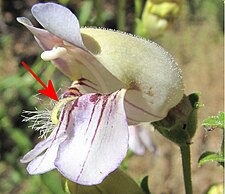Staminode: Difference between revisions
No edit summary |
cap Tags: Mobile edit Mobile web edit Advanced mobile edit |
||
| Line 5: | Line 5: | ||
[[Image:Staminode 1509.JPG|thumb|right|225px|The arrow points to the hairy staminode of a Grinnell's Penstemon (''Penstemon grinellii'') flower]] |
[[Image:Staminode 1509.JPG|thumb|right|225px|The arrow points to the hairy staminode of a Grinnell's Penstemon (''Penstemon grinellii'') flower]] |
||
Sometimes, the staminodes are modified to produce [[nectar]], as in the |
Sometimes, the staminodes are modified to produce [[nectar]], as in the witch hazel ''([[Hamamelis]])''.<ref>jin lu mei shu. Hamamelis Linnaeus, Sp. Pl. 1: 124. 1753. Flora of China 9: 32. 2003</ref> |
||
Staminodes can be a critical characteristic for differentiating between species, for instance in the orchid genus ''[[Paphiopedilum]]'', and among the [[penstemon]]s. |
Staminodes can be a critical characteristic for differentiating between species, for instance in the orchid genus ''[[Paphiopedilum]]'', and among the [[penstemon]]s. |
||
Revision as of 00:47, 19 September 2023
This article relies largely or entirely on a single source. (January 2023) |
In botany, a staminode is an often rudimentary, sterile or abortive stamen, which means that it does not produce pollen.[1] Staminodes are frequently inconspicuous and stamen-like, usually occurring at the inner whorl of the flower, but are also sometimes long enough to protrude from the corolla.

Sometimes, the staminodes are modified to produce nectar, as in the witch hazel (Hamamelis).[2]
Staminodes can be a critical characteristic for differentiating between species, for instance in the orchid genus Paphiopedilum, and among the penstemons.
In the case of Cannas, the petals are inconsequential and the staminodes are refined into eye-catching petal-like replacements.
A spectacular example of staminode is given by Couroupita guianensis, a tropical tree growing in South America also known as cannonball tree.
